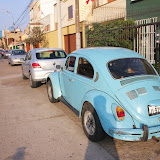

Aftershock, released on July 22 in over 4,000 Chinese movie theatres has a lot of hopes riding on it: The film cost around 100 million yuan to produce, it’s helmed by Feng Xiaogang, the nation’s most commercially successful director, and it’s the first IMAX-quality film to be produced outside the United States. The film has been heavily marketed—posters are everywhere and word of mouth campaigns have sought to hype it as an irresistibly engaging tear-jerker. With your ticket, theatres hand out little tissue packets for the unavoidable tears. With so much public interest, the film can’t wholly fail, the question is, with so much to prove, can it succeed?
Posters imply it to be a disaster movie, but it's aiming at something far more subtle—and far more ambitious. The film is set in Tangshan, a city outside Beijing which in 1972 suffered the most deadly earthquake of the 20th century. Within a matter of minutes, 250,000 people died. The film follows the lives of a single family of four, sundered by the earthquake which forces the mother (played by Xu Fan, the director’s wife) to choose which of her two children to save.
Within the first half-hour, the earthquake has occurred and lives have been scarred forever. What follows is an examination of how people deal with such a disaster and continue on with their lives. The movie reveals itself to be a family drama, far less concerned with collapsing buildings than the with people in them and much more invested in piecing things back together than blowing them up.
The twists and turns of characters lives plays out against the backdrop of a changing China. Every event and every item in the meticulously designed sets is weighted with symbolism: A pair of married PLA soldiers in the 70s decorate their child’s room with era-appropriate propaganda posters; a family argument, taking place during the 80s, occurs as the characters are moving a refrigerator—an item just coming into coming use at the time; by the ‘90s, one character is teaching English and another is driving a car.
Such ambitions have their drawbacks. All this effort to make everything represent something larger means that nothing feels true to itself. A character goes off to work as a migrant worker, ten years later he is successful and driving his own car. Another character gets pregnant and contemplates getting an abortion. Many such actions, events, and decisions seem to occur not from the natural development of the characters, but because they serve to evoke a particular issue in Chinese society.
Likewise, those detailed sets, packed with so much significance, are often too nice. The interiors of character’s houses seem as realistic as the apartments on an episode of Friends. And, for all the attention to detail, the inclusion of blatant product placements is incredibly distracting—the audience I was in laughed when the camera paused for an extended time on a baijiu label. (The crassness of the advertising might have been lessened had the baijiu company not run the clip during the pre-movie trailers.)
The issue of product placement speaks to the current state of cinema in China. The country is on track to produce nearly 500 films this year and box office sales are up around 80% over last year. The CEO of IMAX has tripled the pace of new theatre construction and efforts are under way to develop mobile theatres to serve third and forth tier cities—China has around thirty cities of 1 million people that lack “an established multiplex structure.” Yet, despite all this, movies are still running at a loss. Easy access to bootlegs is a big reason as it depresses box office revenue, legitimate DVD sales, and the price studios can demand of tv stations for broadcast rights. The baijiu placement, however, nearly covered the cost of the movie.
The decision to hire Feng as the director was also a function of commercial calculation. His recent movies—The Banquet, If You Are the One, and The Assembly—have all been very successful and he himself is know as “pretty good at marketing films.” There is certainly much to admire: Feng and his cinematographer, Lu Yue, have created some beautiful moments—a particularly striking image is that of Tangshan on a New Year’s night, lit by the lights of a thousand burning joss paper stacks.
More generally, all those involved in the production of the movie should be commended for grappling with such a serious event. Tangshan may be the most deadly earthquake, but the film is being viewed with the memory of Sichuan’s earthquake fresh in people’s minds. (For comparison, it’s important to remember that United 93 and World Trade Center came out five years after 9/11 and met with public apathy.)
The movie is being compared to Sophie’s Choice in which Meryl Streep plays a mother, a Polish Jew forced to decide in a split second which of her children will die, but there is an important difference: Whereas Sophie’s fateful choice remained shrouded in mystery and serves as the crux of that film, the mother’s choice in Aftershock comes early, before we have much chance to care about the characters. This is, ultimately, the movie’s great flaw. Events are often too shallow, characters tend toward the two-dimensional, and a great deal of the emotion it creates comes from reminding audiences of something they really did emotionally connect with. The film itself, while good in many ways, never quite earns its tears.
















































